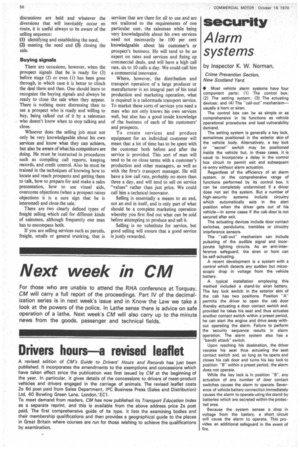security
Page 58

If you've noticed an error in this article please click here to report it so we can fix it.
Alarm systems
by Inspector K. W. Norman,
Crime Prevention Section, New Scotland Yard.
• Most vehicle alarm systems have four component parts: (1) The control box; (2) The setting system; (3) The actuating devices; and (4) The "call-out" mechanism— usually a horn or siren.
The control box can be as simple or as comprehensive in its functions as vehicle operational procedures and load vulnerability demand.
The setting system is generally a key lock, sometimes positioned in the exterior skin of the vehicle body. Alternatively, a key lock or -secretswitch may be positioned inside the vehicle but, in these cases, it is usual to incorporate a delay in the control box circuit to permit exit and subsequent re-entry without alarm actuation.
Regardless of the efficiency of an alarm system, or the comprehensive range of functions performed by its control box, it can be completely undermined if a driver does not set the system. But a number of high-security systems include circuitry which automatically sets in the alert position when the driver gets out of his vehicle—in some cases if the cab door is not secured after exit.
The actuating devices include door contact switches, pendulums, trembles or circuitry interference sensors.
The "call-out" mechanism can include pulsating of the audible signal and incorporate lighting circuits. As an anti-interference safeguard, the siren or horn can be self-actuating.
A recent development is a system with a control which detects any sudden but microscopic drop in voltage from the vehicle battery.
A typical installation employing this method included a stand-by siren battery. The key lock switch in the exterior skin of the cab has two positions. Position "A" permits the driver to open the cab door thereby actuating a door contact switch and, provided he takes his seat and thus actuates another contact switch within a preset period, he can start the engine and drive away without operating the alarm. Failure to perform the security sequence results in alarm operation. The alarm system also has a "bandit attack" switch
Upon reaching his destination, the driver vacates his seat thus actuating the seat contact switch and, so long as he opens and closes his cab door and turns his key lock to position 13" within a preset period, the alarm does not operate.
While the key lock is in position "B". any actuation of any number of door contact switches causes the alarm to operate. Severence of vehicle battery connection immediately causes the alarm to operate using the stand-by batteries which are secreted within the protected area.
Because the system senses a drop in voltage from the battery, a short circuit will cause the alarm to operate. This provides an additional safeguard in the event of fire.
























































































































